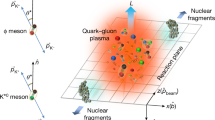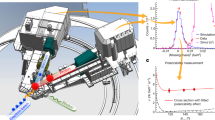Abstract
Conversi, Pancini and Piccioni1, and others2, observed decay electrons from positive mesons coming to rest in solids of either light or heavy elements. For negative mesons, however, decay electrons were found in light elements only ; for heavy elements it is generally assumed that negative mesons are captured by atomic nuclei before they can decay. The absence of capture of positive mesons can be understood as being due to the influence of Coulomb repulsion3 ; its absence for negative mesons in light nuclei has led Fermi, Teller and Weisskopf4 to the conclusion that the interaction between nuclei and mesons is much weaker than was assumed hitherto. These authors show that it takes less than 10-12 sec. for a meson to reach an energy of about 1,000 eV., where its velocity is about equal to that of electrons in outer orbits, that is, 108 cm./sec. They then consider that the meson quickly loses its remaining energy, reaching the K-orbit of an atomic nucleus in about 10-12 sec. It should then be captured by the nucleus in about 10-18 sec. if current ideas of interaction between mesons and nuclei are correct. In doing so they have, however, considerably overestimated the energy transfer from slow mesons to electrons5. In the present communication reasons are given for believing that in dielectrics the time required by a meson to reach a K-orbit is longer than estimated by Fermi et al., but that it would be very difficult to decide from theoretical considerations whether this time may be of the same order as the decay time ( 2 106 sec.).
This is a preview of subscription content, access via your institution
Access options
Subscribe to this journal
Receive 51 print issues and online access
$199.00 per year
only $3.90 per issue
Buy this article
- Purchase on Springer Link
- Instant access to full article PDF
Prices may be subject to local taxes which are calculated during checkout
Similar content being viewed by others
References
Conversi, Pancini and Piccioni, Phys. Rev., 71, 209 (1947).
Sigurgeirsson and Yamakawa, Phys. Rev., 71, 319 (1947).
Tomonaga and Araki, Phys. Rev., 58, 90 (1940).
Fermi, Teller and Weisskopf, Phys. Rev., 71, 314 (1947).
Fröhlich, Nature, 160, 255 (1947). Rosenberg (unpublished).
Fröhlich, Proc. Roy. Soc., 160, 230 (1937), eq. (17). Fröhlich and Pelzer, E.R.A. Report L/T 184.
Huby (unpublished).
Author information
Authors and Affiliations
Rights and permissions
About this article
Cite this article
FRÖHLICH, H., HUBY, K., KOLODZIEJSKI, R. et al. Decay and Capture of Slow Mesons in Dielectrics. Nature 162, 450–451 (1948). https://doi.org/10.1038/162450b0
Issue Date:
DOI: https://doi.org/10.1038/162450b0
Comments
By submitting a comment you agree to abide by our Terms and Community Guidelines. If you find something abusive or that does not comply with our terms or guidelines please flag it as inappropriate.



